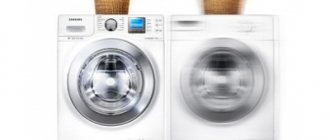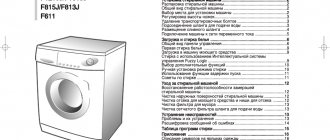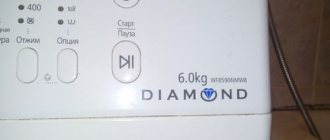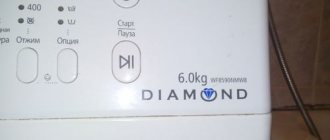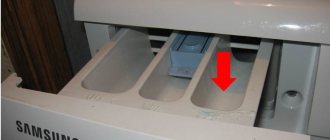Operating manual for washing machine WF...
Washing machine instruction manual
- Image
- Text
- Content
WF7704N1-02495A-03_RU(YLP)
2007.11.8
11:25 AM Rade 1
Manual
washing machine
WF7704N1(W/V/S/C/R/B) WF7702N1(W/V/S/C/R/B) WF7700N1(W/V/S/C/R/B) WF7708N1(W/V/S/ C/R/B)
WF7604N1(W/V/S/C/R/B) WF7602N1(W/V/S/C/R/B) WF7600N1(W/V/S/C/R/B) WF7608N1(W/V/S/ C/R/B)
WF7522N1(W/V/S/C/R/B WF7520N1(W/V/S/C/R/B WF7528N1(W/V/S/C/R/B
WF7452N1(W/V/S/C/R/B WF7450N1(W/V/S/C/R/B WF7458N1(W/V/S/C/R/B
WF7350N1(W/V/S/C/R/B WF7358N1(W/V/S/C/R/B
Precautions………………………………………………………2
Installing a washing machine……………………………3
Unpacking the washing machine…………………………………… 3
Brief description of the washing machine…………………………. 3
Choosing a place to place the washing machine………..3
Adjusting the feet for leveling………………………….. 3
Removing shipping screws…………………………..4
Connecting the water supply hose…………………………….4
Installing the drain hose …………………………………………. 4
Connecting the washing machine to the power supply ………… 5
Washing a load of laundry…………………..6
Control panel overview………………………………………………………. 6
First wash…………………………………………………………… 7
Loading detergent into the washing machine..7
Washing clothes by hand………………………………….. 7
Selection of parameters………………………………………………………..8
Washing tips………………………………………………………. 8
Washing machine maintenance…………………… 9
Repairing a frozen washing machine…………………………9
External cleaning of the washing machine………………………….. 9
Cleaning the drain filter…………………………………………… 9
Cleaning the water hose strainer……………. 9
Troubleshooting………………………………………..10
Problems and solutions……………………………10
Information about messages……………………………………………10
Program table………………………………………………………11
Appendix……………………………………………………….. 12
Fabric care table……………………………………… 12
Electrical safety information……………………………12
Environmental protection……………………………………………………12
Declaration of conformity…………………………………………… 12
Characteristics……………………………………………………….. 13
Register your product with
www.samsung.com/global/register
CODE NUMBER: □S68-02495D-03_Ri
- Washing Machine Operating Instructions Precautions Before Use
- Safety regulations
- Unpacking the washing machine
- Removing shipping screws
- Connecting the washing machine to the power supply
- Control panel overview
- cm stops the current wash step or does not advance to the next step (the remaining wash time shown on the display may increase).
- Selecting parameters
- Repairing a frozen washing machine
- Problems and solutions
- Fabric care table
- Specifications
Mode selection
The control panel of the Samsung machine makes it easy to navigate the washing modes, since they all have verbal symbols. Each is designed for cleaning or rinsing a specific type of product:
Cotton. Used for items with light to moderate soiling (shirts, T-shirts, bed linen, towels, underwear). Duration – up to 3 hours.- Synthetics. The mode is necessary for lightly or moderately soiled blouses, dresses made of polyester or polyamide. Duration – up to 2 hours.
- Hand wash wool . Designed for woolen items that cannot be machine washed. The mode allows loading only up to 2 kg. Duration – 50 minutes.
- Children's. Used for washing baby's clothes. The mode is programmed for high temperature and several rinses. Duration – up to 2.5 hours.
- Intense. The wash is intended for heavily soiled cotton items. Tablecloths, bed linen and towels can be washed. Duration – 2.5 hours.
- Fast 29′ . The accelerated cycle is designed for items that do not need to be cleaned, but require light refreshment and odor removal. Duration – 29 minutes.
- Economical washing . In this mode, low heating occurs and minimal filling of the tank with water occurs.
- Prewash . The laundry is cleaned in two stages, each with its own portion of washing powder.
- Jeans. The function is designed to clean denim items. Provides protection against shedding and fading.
- Outerwear . Used for washing clothes made of elastic fabrics or with filling. Suitable for tracksuits.
- Spin. This function is used if you need to additionally enable centrifugation. Allows you to speed up drying of clothes. Duration: approximately 5 minutes
- Rinse + Spin . The mode allows you to supplement a standard wash with rinsing or refresh your laundry with conditioner. Duration – up to 20 minutes.
The exact duration of each mode may vary within small limits among different Samsung models.
More information about the modes can be found here.
Precautions, Before use, Safety instructions
Page 2
- Image
- Text
WF7704N1-02495A-03_RU(YLP)
2007.11.8
11:25 AM Page 2
Precautionary measures
Congratulations on your purchase of a Samsung washing machine. This instruction manual contains important
information on installation, use and care of the machine. Please take the time to read these instructions for
Full use of the machine's capabilities for many years.
Before use
Packaging material may be dangerous for children, store all packaging material (plastic bags, polystyrene
etc.) out of the reach of children.
The washing machine is intended for domestic use only.
Water and electrical connections should only be carried out by qualified personnel who follow the manufacturer's instructions (see page 3 "Installing the washing machine") and local safety regulations.
Before using your washing machine, you must remove all packaging and shipping screws. Otherwise, the washing machine may be seriously damaged. See "Removing Shipping Screws" on page 4.
Before the first wash, you must run a full wash cycle without loading clothes. See page 6 section “First
wash"
Safety regulations
Before cleaning or servicing, unplug the washing machine.
Make sure the pockets of clothes to be washed are empty.
The presence of hard, sharp objects such as coins, pins, nails, bolts or pebbles may cause
serious damage to the washing machine.
Always disconnect the washing machine from the electrical and water supply after use. Before opening the washing machine door, make sure that the water has drained completely. If there is water in the washing machine, do not open the door.
Pets or children may get into the washing machine. Check your washing machine every time
use.
The glass door gets very hot during washing. Keep children away from the washing machine while it is operating.
Do not attempt to repair the washing machine yourself. Repairs performed by inexperienced and unqualified personnel may cause injury and/or require more serious repairs.
repair.
If the plug (power cord) of this product is damaged, it must be replaced by the manufacturer.
service technician or qualified personnel for safety reasons. This washing machine must be repaired exclusively at authorized service centers and only with
using original spare parts.
This washing machine is not intended for use by children or disabled persons unless use is
is carried out under the appropriate supervision of a responsible person to ensure safe use of the washing machine
cars. Do not allow young children to play with the washing machine.
Connecting the washing machine to the electrical network must be done using a plug socket,
designed for the appropriate power.
The washing machine must be placed in such a way as to ensure easy access to the plug. Do not use water containing oil, cream or lotion sold in cosmetic stores or used in massage parlors. This may cause the housing to become deformed, resulting in improper operation or water leakage. Stainless steel drums usually do not rust. However, if metal objects, such as a hair clip, are left in the drum for a long time, it may become rusty. —
Do not leave water or chlorine bleach in the drum for a long time.
—
Do not leave water containing iron in the drum for a long time.
— If rust appears on the surface of the drum, clean it with a neutral detergent and a sponge or soft cloth (never use a wire brush). The carpet should not block the ventilation holes in the washing machine body, if any. Use new hoses; old hoses are not recommended.
The WEEE label only applies to EU countries.
This marking, whether on the product or in the manual, indicates that the product should not be disposed of with other household waste at the end of its useful life. To prevent
possible harmful effects on the environment or human health from uncontrolled
waste disposal, separate it from other types of waste for appropriate recycling and reuse.
use as raw materials.
Consumers should contact either the retailer of the device or their local government
administration for detailed information about the place and method of environmentally safe disposal.
Legal entities need to contact the supplier to check the terms and conditions of the purchase and sale agreement. This product must not be disposed of with used containers.
• SAVE THESE OPERATING INSTRUCTIONS
2
Errors (on screen) and what to do about them?
If problems arise during operation, a specific code is displayed on the display of the washing machine. Each defect is encrypted with its own designation. Simple breakdowns can be fixed with your own hands. To resolve more complex faults, you must call a specialist.
The list of errors includes:
, 4E1, 4C. Problems with water supply. It is necessary to check the position of the hoses and the presence of foreign objects in the valve.- , 5C, . The unit does not drain water. It is necessary to exclude clogging of the pipe, pinching of the hose, or a defect in the pump impeller.
- 9E1, 9E2, Uc. Power failure. You need to check that your network connection is correct.
- HE, HC, E5, E Water does not heat up. You need to check the connection of the device or repair the heating element.
- SUD, (SD). Lots of foam. The dose of powder should be reduced or replaced with another variety.
- , UB, E4. Imbalance in drum operation. It is necessary to adjust the amount of linen or sort it correctly according to the quality of the fabric.
- , LC, . Spontaneous drainage of water. It is necessary to adjust the position of the drain hose or prevent damage to the tank.
- , EA. The motor does not work. It is necessary to eliminate the overload or repair the electric motor.
- DE, DC, ED. The hatch door is not closed. You need to close the door or replace the electric lock mechanism.
- TE, TC, EU. There is no signal from the temperature sensor. It is necessary to repair the sensor or restore its wiring.
- 1E, 1C, E7. There is no signal from the water sensor. The sensor should be replaced or its wiring checked.
Read about error codes for Samsung washing machines in this section.
Installing the washing machine, Removing the transport screws, Connecting the water supply hose
Drain hose connection, Above the edge of the sink, In the drain pipe branch, In the drain pipe
- Image
- Text
WF7704N1-02495A-03_RU(YLP)
2007.11.8
11:25 AM Page 4
Washing machine installation
Removing shipping screws
Before using the washing machine, you must remove all transport screws from the rear panel.
To remove screws:
1. Before removing, unscrew the screws with a wrench.
2.Grip the head of the screw and pull it out through the wide part
holes. Repeat these steps for each screw. The transport screws must be removed together with
the bushings into which they are inserted, so that the bushings do not get inside the washing machine.
3. Cover the holes with the supplied plastic caps. 4. Save the shipping screws for later
use.
Connecting the water supply hose
The water supply hose must be connected at one end to the washing machine and the other to the water supply.
valve. Do not stretch the water supply hose. If the hose is too short and you don't want to change the water valve, replace the hose with a longer high-pressure hose.
Connecting the water supply hose: 1. Take the elbow fitting of the cold water supply hose and
Connect it to the cold water inlet on the back of the washing machine. Screw it in by hand.
2. Connect the other end of the hose to the cold water valve and
screw it in by hand. If necessary, you can change the position of the water supply hose on the washing machine side by unscrewing the fitting, turning the hose and screwing the fitting back on.
Connecting the drain hose
The end of the drain hose can be placed in three positions:
Over the edge of the sink
The drain must be organized in such a way that along the length
a 1.5 m hose had an inflection point from 60 to 90 cm.
Also, the drainage organization must ensure free outflow
water into the sewer. To ensure that the end of the drain hose is bent, use a hose holder. To prevent the drain hose from moving, secure the holder.
in a drain pipe branch
The branch of the drain pipe must be located above the drain siphon, so that the end of the hose is located at least 60 cm above the floor.
in the drain pipe
Samsung recommends using a 65 cm long vertical pipe for this purpose. Pipe length is not
must be less than 60 cm and exceed 90 cm.
4
How to care for a household appliance after use?
After the appliance has finished working and the laundry has been removed from the drum, you need to wipe the drum and the inside of the door dry.
Also, use a dry cloth or sponge to blot the rubber rim of the cuff, in which water accumulates . To dry the machine, the door is temporarily left open and the powder container is pulled out.
After each wash, it is advisable to unplug the machine. Voltage fluctuations in the power supply can negatively affect household appliances.
Periodically (about once every 1-2 months) the device is thoroughly cleaned. To do this, take out the powder receptacle and rinse it completely. To remove scale from the heating element, do a dry wash with any descaling agent.
It is useful to carry out preventive washing with special agents against mold , which accumulates when the device is not sufficiently dried.
After every tenth wash, you should check the filter for accumulation of debris and small parts.
Read about how to clean a Samsung washing machine in this material.
General information
Washing machines from this company have firmly taken their place in the household appliances market. This is due to a combination of attractive appearance, practicality and a large selection of washing machines with various functions. Separately, we need to highlight the Samsung Diamond model line.
In these models, you can always choose a washing machine that meets all the requirements for the volume of loaded laundry, dimensions, color, and set of functions. All equipment has a low energy consumption class, this is an important indicator for saving energy.
Attention: An absolute advantage is the large number of Samsung service centers around the world. This makes it possible to quickly solve a problem related to the operation of this company’s equipment.
